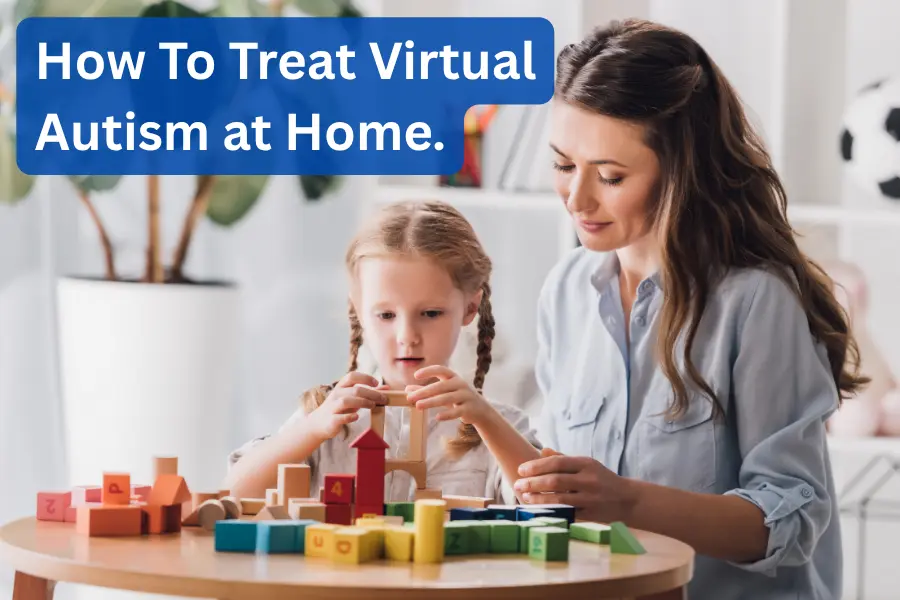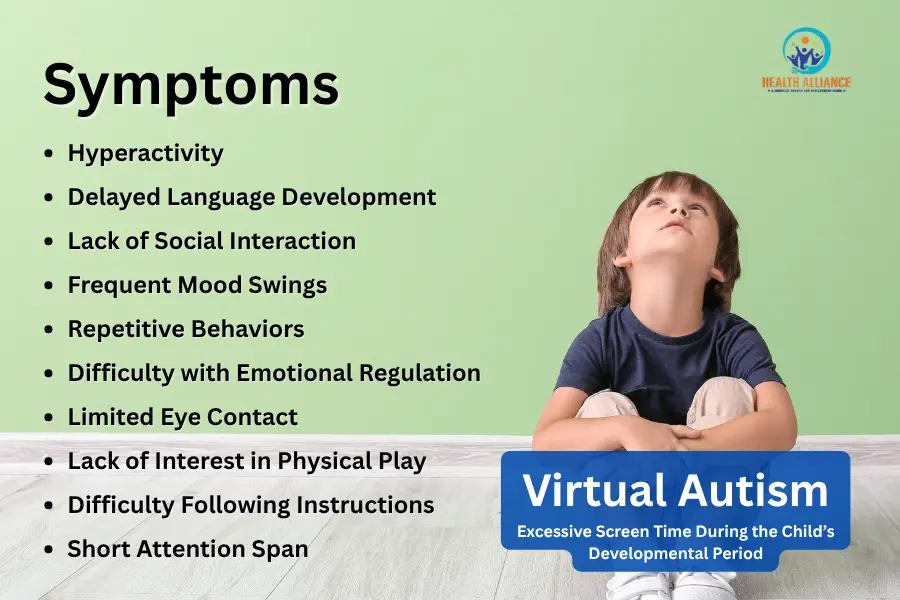How To Treat Virtual Autism at Home.
Health Alliance
June 20, 2025

In today’s digital era, smartphones or TV screens have become a part of children’s everyday lives, often starting from infancy. When a child cries, parents turn to the phone or TV instead of toys to soothe him. Technology offers convenience and entertainment, but its excessive use has raised a serious concern among pediatricians and child development experts: a phenomenon called Virtual Autism.
Virtual autism refers to a condition in which young children, due to prolonged exposure to screens such as smartphones, tablets or TV, begin to display symptoms similar to the behavioural and developmental delays found in autism spectrum disorder. These include reduced eye contact, delayed speech, poor social interactions, temper tantrums, stress and repetitive behaviour.
The rise in cases of virtual autism is linked to the growing reliance on digital devices such as smartphones, tablets etc. for entertainment and distraction, especially during the crucial early years of a child’s brain development. Digital devices can stunt the development of the child’s brain.(Sources: https://hms.harvard.edu/news/screen-time-brain) What makes this issue even more worrying is that many parents inadvertently resort to digital devices while trying to keep their children busy or quiet. This leads to children becoming irritable, not talking to people, or getting annoyed over small things.
But the good news for our readers? Virtual autism can be cured, especially if it is caught early. With timely attention and lifestyle changes – mainly reducing screen time and replacing it with meaningful conversations – children can recover and move forward.
This article is written to help parents understand what virtual autism is, why it occurs, and most importantly, how to treat it at home using natural and supportive methods. Whether you are noticing early signs or want to take preventive steps, this guide is here to support your child’s development.
What is Virtual Autism?

Virtual autism refers to a condition in which children develop autistic-like traits due to excessive exposure to screens of TV, tablets, smartphones, especially in children aged 2-3 years. Unlike traditional autism spectrum disorder (ASD), virtual autism is not caused by genetics or neurological abnormalities. Instead, it begins when screens replace essential human interactions that drive a child’s brain development, such as responsive and reciprocal interactions with caregivers.
Common Symptoms
- Hyperactivity
- Delayed Language Development
- Lack of Social Interaction
- Frequent Mood Swings
- Repetitive Behaviors
- Difficulty with Emotional Regulation
- Limited Eye Contact
- Lack of Interest in Physical Play
- Difficulty Following Instructions
- Short Attention Span
Difference Between Traditional Autism and Virtual Autism
Aspect | Traditional Autism | Virtual Autism |
Cause | Genetic/neurodevelopmental | Environmental (excessive screen time) |
Onset | Usually evident from infancy | Develops after prolonged screen use |
Reversibility | Lifelong condition (manageable with intervention and therapies) | Often reversible with intervention and therapies |
Diagnosis | Requires clinical assessment | Clinical and behavioral assessment and can lead to permanent if untreated |
Treatment Approach | Long-term therapy | Early therapeutic interventions |
Early symptoms can often be prevented if screen time is promptly eliminated or reduced and the child is reintroduced to age-mates, conversations, and play. The sooner the intervention, the quicker the recovery.
Step-by-Step Guide For Home Treatment Of Virtual Autism

Eliminate or Reduce Screen Time (Digital Detox)
WHO Guidelines on Screen Time
- Infant (less than 1 year of age): Screen time is not recommended.
- 1-2 years of age: No screen time for a 1-year-old. No more than an hour for 2-year-olds, with less time preferred.
- 3 to 4 years old: No more than one hour.
Source: http://aoa.org/news/clinical-eye-care/public-health/screen-time-for-children-under-5
How to Reduce or Eliminate Screen Time
- Replace the screen time with other activities like play, reading, music, etc.
- Remove TV or tablet from the child’s reach/bedroom
- Avoid using TV screens, smartphones, or tablets during meals, bedtime.
Fun Alternatives to Digital Devices
- Storytelling with puppets
- Drawing, painting, or coloring
- Sensory bins with rice, sand, or water
- Playdough and clay modeling
- Role play (shopkeeper, doctor, etc.)
- Dancing to music or doing action songs
Create a Stimulating, Screen-Free Environment
The Best Option is Toys or other playing material
- Open-ended toys like blocks, Lego, and stacking rings
- Pretend play kits (kitchen sets, toolkits)
- Art supplies (crayons, glue, paper, scissors)
- Musical instruments (drums, xylophones)
- Picture cards, flashcards, alphabet boards
Importance of Outdoor and Physical Play
- Activities like running, jumping, climbing, and ball games improve coordination and confidence
- Exposure to sunlight and fresh air to improve mood and sleep quality
- Group play promotes sharing, turn-taking, and social development
Creating a Sensory-Rich Home Setup
- Set up a calm play corner with books, textures, and cushions
- Use textured materials (fabrics, sponges, sandpaper)
- Rotate toys every few days to keep the environment fresh
Enhance Parent-Child Communication
Importance of Talking, Singing, and Storytelling
- Narrate everyday routines to increase vocabulary (“Get up,” “Brush your teeth”)
- Sing nursery rhymes.
- Tell simple, expressive stories using facial cues and voice modulation
Building Connection through Eye Contact and Emotion
- Sit at your child’s level during interactions
- Maintain eye contact and respond warmly to sounds or actions
- Smile, hug, and use touch to build trust and safety
Home-Based Therapeutic Activities
Speech and Language Enrichment
- Label objects around the house: “This is a cup”, “That’s your nose”
- Encourage repetition through fun games (“Say baa-baa like the sheep!”)
- Use mirrors to help children observe their mouth movements
Simple Occupational Therapy (OT) Activities
- Threading beads or pasta for fine motor skills
- Balancing games like walking on a taped line
- Sensory play: finger painting, dough squishing, water pouring
- Animal walks: crawl like a bear, hop like a bunny
Social Interaction Through Structured Play
- Turn-taking games like rolling a ball back and forth
- Simple board games or puzzles
- Group singing or playdates with other children (screen-free)
Establish a Healthy Daily Routine
Consistency in Meals, Sleep, and Play
- Set a fixed wake-up and bedtime (7–8 AM wake-up, 8–9 PM bedtime)
- Structured play, nap, and eating times reduce anxiety and tantrums
Sample Screen-Free Daily Routine
Time | Activity |
7:00 AM | Wake up, hygiene routine |
8:00 AM | Breakfast & bonding time |
9:00 AM | Outdoor/physical play |
11:00 AM | Story or puzzle time |
12:00 PM | Lunch |
1:00 PM | Nap |
3:00 PM | Sensory play / drawing |
4:00 PM | Snack + parent-child games |
5:00 PM | Outdoor walk or social play |
6:30 PM | Dinner |
7:30 PM | Storytelling + calm music |
8:30 PM | Sleep |
Be a Role Model and Stay Engaged
Avoid Screens Around Children
- Children copy adults—your habits set their expectations
- Keep phones away during family time and meals
- Use “Do Not Disturb” mode to be fully present
Stay Emotionally and Physically Available
- Prioritize 1-on-1 play and conversation
- Be responsive to your child’s cues
- Be consistent with love, boundaries, and routines
Success Stories and Researches
Research conducted in Europe and Asia shows that children with virtual autism showed significant improvement within 1-6 months of screen detox. Case studies have shown overall improvement in language, eye contact, and social behavior with consistent parental involvement.
One French study reported over 80% of children who followed a screen-free protocol no longer showed autism-like symptoms within a few months.
Conclusion
Virtual autism is a modern-day warning sign—not a life sentence. By creating a loving, engaging, and screen-free environment, you can help your child reconnect with the world and develop naturally.
Remember, the most powerful tool for healing is your presence. It’s your face, your words, your love—not screens—that teach your child how to speak, feel, and connect.
Your presence heals more than any device ever could.
If you’re noticing early signs of virtual autism, don’t panic—start today. Turn off all the screens. Look into your child’s eyes. Talk, play, and enjoy with your child. You have everything it takes to support your child at home.
Need help? Reach out to our therapists and share this guide with other parents who might benefit.
